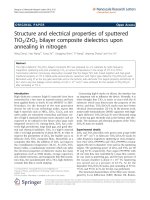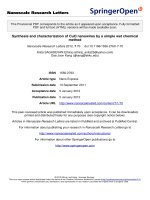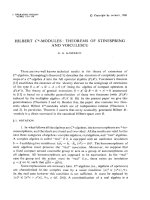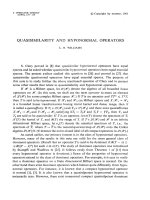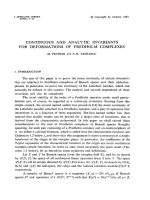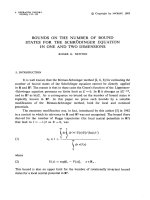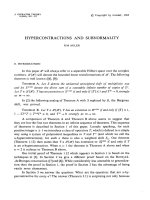Báo cáo toán học: "Anatomy and chemical composition of Pinus pinea L. bark" pdf
Bạn đang xem bản rút gọn của tài liệu. Xem và tải ngay bản đầy đủ của tài liệu tại đây (1.12 MB, 6 trang )
Original
article
Anatomy
and
chemical
composition
of
Pinus
pinea
L.
bark
Elsa
Nunes
a
Teresa
Quilhó
b
Helena
Pereira
a
Centro
de
Estudos
Florestais,
Departamento
de
Engenharia
Florestal,
Instituto
Superior
de
Agronomia,
Universidade
Técnica
de
Lisboa,
1399
Lisboa
Codex,
Portugal
b
Centro
de
Estudos
de
Tecnologia
Florestal,
Instituto
de
Investigação
Científica
Tropical,
1399
Lisboa
Codex,
Portugal
(Received
21
September
1998;
accepted
23
March
1999)
Abstract -
The
secondary
phloem
of
Pinus
pinea
L.
bark
has
sieve
cells
and
axial
and
radial
parenchyma,
but
no
fibres.
Resin
ducts
are
present
in
fusiform
rays.
Styloid
crystals,
starch
granules
and
tannins
occur
inside
sieve
and
parenchyma
cells.
The
rhytidome
of
P.
pinea
bark
has
a
variable
number
of
periderms
forming
scale-type
discontinuous
layers
over
expanded
parenchyma
cells.
The
phellem
comprises
two
to
four
layers
of
thick-walled
cells
and
the
phelloderm
a
layer
of
two
or
three
thin-walled
cells
with
inclu-
sions
and
sometimes
a
layer
of
expanded
cells.
Ash
content
of
P.
pinea
bark
is
low
and
the
pH
is
slightly
acidic.
Total
extractives
amount
to
19.1
%
and
tannins
to
7.2 %
of
o.d.
weight.
Content
of
lignin
and
unhydrolysable
phenolic
acids
is
37.5 %
and
of
polysac-
charides
36.8
%,
with
the
following
monosaccharide
composition:
glucose
44.6
%,
mannose
18.2
%,
xylose
20.7
%,
galactose
7.6
%
and
arabinose
8.9
%.
(©
Inra/Elsevier,
Paris.)
Pinus
pinea
L.
/
bark
/
anatomy
/
chemical
composition
Résumé -
Anatomie
et
composition
chimique
de
l’écorce
de
Pinus
pinea
L.
Le
phloème
secondaire
de
Pinus
pinea
L.
contient
des
cellules
criblées,
du
parenchyme
axial
et
radial
mais
pas
de
fibres.
Les
canaux
résinifères
apparaissent
dans
les
rayons
fusiformes.
Des
cristaux
styloïdes,
des
granules
d’amidon
et
des
tanins
ont
été
observés
dans
les
cellules
criblées
et
le
parenchyme.
Le
rhytidome
renferme
un
nombre
variable
de
péridermes
qui
forment
des
couches
discontinues
en
écailles
sur
des
cellules
de
parenchyme
élargies.
Le
phellème
comprend
de
deux
à
quatre
couches de
cellules à
paroi
épaisse
et
le
phelloderme
une
couche
de
deux
à
trois
cellules
à
paroi
mince
avec
inclusions
et,
parfois,
une
couche
de
cellules
élargies.
La
teneur
minérale
de
l’écorce
de
Pinus
pinea
est
faible
et
le
pH
légèrement
acide.
Les
extractibles
correspondent
à
19,1
%
et
les
tanins
à
7,2
%
(masse
anhydre).
La
teneur
en
lignine
et
en
acides
phénoliques
non
hydrolysables
est
de
37,5
%,
tandis
que
celle
des
polysaccharides
est
de
36,8
%
avec
la
composition
suivante:
glucose
44,6
%,
mannose
18,2
%,
xylose
20,7
%,
galactose
7,6
%
et
ara-
binose
8,9
%.
(©
Inra/Elsevier,
Paris.)
Pinus
pinea
L.
/
écorce
/
anatomie
/
composition
chimique
1.
Introduction
Pinus
pinea
L.
(stone
pine)
is
a
pine
species
of
eco-
nomic
importance,
growing
in
southern
Europe
espe-
cially
in
the
western
Mediterranean
countries,
namely
*
Correspondence
and
reprints
deftec@
mail.telepac.pt
in
the
Iberian
peninsula
and
in
France.
P.
pinea
is
a
species
of
ecological
importance
in
these
regions
and
its
protective
role
for
other
species,
e.g.
cork-oak
and
holm-oak,
is
acknowledged.
In
Portugal,
the
area
forested
with
stone
pine
is
approximately
80
000
ha
and
it
is
expanding
due
to
the
choice
of
this
species
for
many
afforestation
projects.
The
stone
pine
is
used
main-
ly
for
the
production
of
the
edible
pine
nut
but
also
for
timber
and
the
trees
may
be
tapped
for
resin.
The
impor-
tance
of
nut
production
has
increased
with
the
recent
use
of
grafting,
allowing
fruit
production
after
6
years.
The
bark
of
P.
pinea
has
not
previously
been
charac-
terised,
although
the
anatomy
and
chemical
composition
of
its
wood
has
already
been
studied
[2,
6,
12].
Detailed
descriptions
of
the
bark
of
other
Pinus
species,
e.g.
P.
echinata,
P.
taeda,
P.
palustris
and
P.
rigida,
have
been
made
[7,
8]
and
data
on
pine
bark
chemical
composition
have
been
summarised
[5].
A
description
of
P.
pinaster
bark
anatomy
and
chemical
composition
has
recently
been
published
[9].
In
this
paper
we
describe
the
anatomy
and
chemical
composition
of
P.
pinea
bark.
2.
Materials
and
methods
The
material
used
for
analysis
was
obtained
from
commercial
P.
pinea
plantations
from
one
site
in
the
south
of
Portugal
(Albufeira).
Ten
trees
approximately
25
years
old
were
randomly
selected
and
bark
samples
were
taken
at
breast
height.
For
determination
of
the
chemical
composition,
a
composite
sample
was
prepared
by
mixing
aliquots
of
the
bark
of
each
tree
sampled.
The
composite
sample
was
milled
and
the
granulometric
fraction
40-60
mesh
was
used
for
analysis.
The
chemical
composition
was
determined
using
standard
methods
for
wood
analysis
[15]
with
adaptations
reported
for
cork
chemical
analysis
[11]
and
used
previously
for
the
analysis
of
maritime
pine
bark
[9].
Extractives
were
determined
using
successive
extrac-
tions
with
dichloromethane,
ethanol
and
water.
Suberin
content
was
determined
on
extractive-free
bark:
1.5
g
were
reacted
under
reflux
with
a
sodium
methoxide
solu-
tion
in
methanol
(250
mL
methanol
and
2.7
g
Na)
for
3
h
and
further
with
100
mL
methanol
for
15
min
after
filtra-
tion;
the
combined
filtrates
were
acidified
to
pH
6
with
a
2
M
sulphuric
acid
solution
in
methanol,
evaporated
to
dryness
and
the
residue
suspended
in
water;
the
alcohol-
ysis
products
were
extracted
three
times
with
200
mL
chloroform,
dried
over
sodium
sulphate
and
evaporated
to
dryness.
The
desuberinised
residue
was
hydrolysed
and
the
hydrolysate
used
for
separation
and
quantifica-
tion
of
monosaccharides
as
alditol
acetates
by
gas
chro-
matography.
The
residue
of
hydrolysis
was
weighted
as
lignin
and
phenolic
acids.
Total
phenols
and
tannins
were
determined
in
the
extracts
obtained
by
successive
extractions
with
ethanol
and
water
and
spectrophotometric
measurement
at
765
nm
after
reaction
with
Folin-Ciocalteu
reagent
using
gal-
lic
acid
for
calibration
[11].
The
determination
of
tannin
content
used
methylcellulose
as
absorbent:
10
mL
extract
were
added
to
10
mL
of
a
0.04
%
solution
of
methylcellulose
of
high
substitution
degree,
8
mL
of
a
saturated
ammonium
sulphate
solution
and
25
mL
water;
after
20
min
this
was
filtered
and
the
phenol
content
in
the
filtrate
determined
as
previously.
Tannin
content
was
calculated
as
the
difference
between
total
phenols
and
phenols
remaining
after
tannin
absorption.
Total
nitrogen
was
determined
by
the
Kjeldahl
method.
The
pH
was
measured
in
a
suspension
of
2
g
bark
in
100
mL
distilled
water.
The
anatomy
studies
were
carried
out
using
the
bark
of
the
individual
trees
sampled.
Microscopic
sections
of
10
μm
in
thickness
were
prepared
for
optical
microscopy
using
a
Reichter
sliding
microtome
after
penetration
with
DP
1500
polyethylene
glycol
[14],
and
stained
with
a
triple
staining
with
chrysodine
pyronine
and
astra
blue.
Sudan
4
was
used
for
suberin
detection.
Observations
were
also
made
by
light
microscopy
on
dissociated
ele-
ments.
The
samples
were
macerated
in
acetic
acid
and
hydrogen
peroxide
1:1
at
60 °C
for
48
h
and
the
macerat-
ed
material
was
stained
with
astra
blue.
The
terminology
used
for
the
anatomical
description
mainly
followed
Trockenbrodt [17].
3.
Results
and
discussion
The
stone
pine
(Pinus
pinea
L.)
has
a
thick
scale
bark
of
a
strong
brown
reddish
colour.
The
bark
anatomy
of
Pinus
pinea
L.
shows
three
structural
layers
from
cambium
to
the
outside
(figure
1a,
b):
the
secondary
phloem,
the
innermost
periderm
and
the
rhytidome
(which
includes
a
variable
number
of
peri-
derms).
The
anatomical
characteristics
observed
were
similar
for
all
trees.
The
anatomy
is
similar
to
that
of
the
bark
of
P.
pinaster
[9]
and
other
Pinus
spp.
[7,
8].The
secondary
phloem
includes
sieve
cells
(Sc),
axial
parenchyma
(p)
and
rays
(r)
(figure
1a,
b).
No
fibres
were
found
and
this
agrees
with
general
observations
for
the
genus
Pinus
[4].
Sieve
cells
are
elongated
with
unlignified
thin
walls
and
with
many
lateral
sieve
areas
(figure
2).
The
sieve
cells
nearest
to
the
cambium
are
radially
aligned
but
this
alignment
is
subsequently
lost
by
distortion
towards
the
outside
through
cell
collapse
due
to
loss
of
turgidity
[7].
This
distortion
is
particularly
obvious
near
the
innermost
periderm.
parenchyma
cells
(p)
are
thin-walled,
approxi-
mately
circular
in
cross
section
and
scattered.
They
have
styloid
crystals
(c)
(figure
3)
and
starch
granules.
It
has
been
reported
for
southern
pine
[7]
that
styloid
crystals
are
composed
of
calcium
oxalate
and
that
they
are
abun-
dant
throughout
the
innerbark
and
rhytidome,
deposited
as
a
metabolic
by-product.
The
phloem
rays
(r)
are
similar
to
the
xylem
rays,
uniseriate
and
homocellular.
Albuminous
cells
form
the
margins
of
some
rays.
Fusiform
rays
with
resin
ducts
are
also
observed
(figure
4).
Rays
extend
linearly
through
the
non-collapsed
phloem,
but
near
the
periderm
the
alignment
is
lost.
The
transition
from
non-collapsed
to
collapsed
phloem
is
gradual
and
signalled
by
the
col-
lapse
of
sieve
cells
and
loss
of
their
radial
and
tangential
alignment,
the
distortion
of
rays
and
the
expansion
of
parenchyma
cells.
These
changes
represent
the
adjust-
ment
of
the
secondary
phloem
to
the
radial
tree
growth,
as
reported
for
P.
pinaster
[9]
and
for
other
species
of
the
genus
Pinus
[7,
8]
as
well
as
for
other
genera
[1,
13,
16].
The
periderm
(Pr)
is
made
up
of
phellem
(Pm),
phel-
logen
and
phelloderm
(Pd)
(figures
1a,
5).
In
each
perid-
erm,
the
samples
showed
a
variable
number
of
cells
in
the
phellem
and
phelloderm
layers.
The
phellem
includes
layers
of
two
to
four
radially
aligned
thick-walled
and
sclerified
cells
(Scl),
sometimes
with
many
inclusions
(figure
5).
A
band
of
suberised
cells
alternating
with
thick-walled
cells
was
not
observed,
as
described
for
other
Pinus
spp.
[7].
The
phelloderm,
located
to
the
inte-
rior
of
the
phellogen,
has
two
types
of
cells:
near
the
phellogen,
two
to
three
layers
of
thin-walled
cells
with
numerous
inclusions;
then
one
layer
of
thin-walled,
radi-
ally
expanded
cells
(figure
5,
arrow)
and
may
be
con-
fused
with
cells
from
the
expanded
parenchyma
(ex)
(figure
5).
The
variable
number
of
cells
in
the
phellem
and
phelloderm
layers
in
each
periderm
agrees
with
Howard
[7]
who
found
that in
the
bark
of
southern
pine
the
amount
of
tissue
in
the
periderm
may
vary
within
a
single
sample.
In
P.
pinea,
similar
to
P.
pinaster
and
other
Pinus
spp.,
the
periderm
is
discontinuous,
following
an
irregu-
lar
path
around
the
stem.
The
periderms
form
layers
with
edges
curving
outwards
to
merge
with
older
periderms;
the
phloem
is
thus
isolated
in
a
scale-type
pattern
and
the
outer
bark
forms
a
scalebark.
The
rhytidome
(Rt)
has
a
variable
number
of
periderms
(on
average
three
perid-
erms)
that
overlap
enclosing
a
phloem
tissue
that
is
mainly
made
up
by
expanded
parenchyma
cells
many
times
larger
than
their
original
diameters
(figure
5).
This
type
of
cell
change
at
the
outside
of
the
innermost
perid-
erm
has
been observed
in
P.
pinaster
[9],
in
southern
pines
[7]
and
also
in
other
genera
[3].
These
expanded
parenchyma
cells
(ex)
occupy
a
large
volume
fraction
of
the
rhytidome
and
contribute
to
its
porous
structure;
they
are
sensitive
to
fracture
and
determine
the
external
mor-
phology
of
the
rhytidome,
which
is
kept
together
by
the
sclerified
cells
(Scl)
of
the
periderm.
The
rhytidome
of
P.
pinea
has
a
high
amount
of
material
deposited
in
the
lumens,
mainly
tannins,
which
gives
the
bark
its
strong
reddish
brown
colour.
The
chemical
composition
of
pine
bark
is
summarised
in
table
I.
Extractives
amount
to
19,1
%
and
include
mainly
polar
compounds
extracted
by
ethanol
and
water
(14.0
%
of
o.d.
bark);
approximately
half
of
the
extrac-
tives
(7.2
%
of
o.d.
bark)
are
of
phenolic
character
and
correspond
to
tannins
which
amount
to
96
%
of
total
phenolics
(table
II).
The
microscopic
observations
show
that
tannins
are
deposited
in
the
cell
lumens
of
the
rhytidome
(figure
5).
The
suberin
content
is
low,
in
accordance
with
the
small
number
of phellem
cells
found
in
the
rhytidome
and
the
fact
that
they
were
thick-walled
and
sclerified
(figure
5).
Consequently,
lignin
and
unhy-
drolysable
polyphenol
content
is
high,
amounting
to
%
of
the
o.d.
bark.
The
monomeric
composition
of
polysaccharides
(table
III),
which
correspond
on
average
to
approximately
37
%
of
pine
bark,
shows
a
predomi-
nance
of
glucose.
In
the
hemicelluloses,
xylans
and
man-
nans
have
almost
similar
importance,
20.7
and
18.2
%,
respectively,
of
total
monosaccharides.
Arabinose
is
pre-
sent
in
considerable
amounts
(9
%
of
monosaccharides).
In
comparison
to
the
chemical
composition
of
other
Pinus
species
[5,
9],
P.
pinea
bark
shows
a
content
of
extractives
similar
to
P.
sylvestris
and
P.
taeda
(20.7
and
18.3
%,
respectively),
higher
than
P.
pinaster
(11.4
%)
and
lower
than
P.
elliotti
(35.8
%).
The
content
of
total
polysaccharides
is
lower
than
in
P.
pinaster
and
P.
sylvestris.
The
proportion
of
xylans
is
higher
than
in
P.
sylvestris
(12.6
%
of
total
monosaccharides)
and
lower
than
in
P.
pinaster
(26.1
%).
The
bark of
stone
pine
is
slightly
acidic
(pH
4.5)
and
total
nitrogen
content
is
0.76
%.
4.
Conclusions
The
bark
anatomy
of
P.
pinea
L.
is
similar
to
that
of
P.
pinaster
and
other
Pinus
spp.
The
secondary
phloem
of
P.
pinea
has
sieve
cells
and
axial
and
radial
parenchy-
ma,
but
no
fibres.
Resin
ducts
are
present
in
fusiform
rays
and
styloid
crystals,
starch
granules
and
tannins
occur
inside
sieve
and
parenchyma
cells.
The
rhytidome
of
P.
pinea
has
a
variable
number
of
periderms
as
scale-
type
discontinuous
layers
over
expanded
parenchyma
cells.
The
phellem
has
a
small
number
of
thick-walled
and
small
suberised
cells.
The
chemical
composition
of
P.
pinea
bark
shows
a
considerable
amount
of
tannins
and
a
relatively
low
con-
tent
of
polysaccharides.
Acknowledgements:
The
authors
thank
Cristiana
Alves
and
Cristina
Leonor
for
their
technical
assistance.
References
[1]
Alfonso
V.,
Richter
H.,
Wood
and
bark
anatomy
of
Buchenavia
Eichl
(Combretaceae),
IAWA
Bull.
n.s.
12
(1991)
123-141.
[2]
Carvalho,
A.,
Madeiras
Portuguesas.
Estrutura
anatómi-
ca.
Propriedades
e
utilizações,
Vol.
II,
Direcção
Geral
das
Florestas,
Lisboa,
1997.
[3]
Chattaway
M.M.,
The
anatomy
of
bark.I.
The
genus
Eucalyptus,
Aust.
J.
Bot.
1 (1953)
402-433.
[4]
Esau
K.,
Anatomy
of
Seed
Plants,
J.
Wiley
&
Sons,
New
York, 1977.
[5]
Fengel
D.,
Wegener
G.,
Wood
Chemistry,
Ultrastructure,
Reactions,
Walter
de
Gruyter,
Berlin,
1989.
[6]
Greguss
P.,
Identification
of
living
Gymnosperms
on
the
basis
of
xylotomy,
Akadémiai
Kiadó,
Budapest,
1955.
[7]
Howard
E.T.,
Bark
structure
of
the
southern
pines,
Wood
Sci.
3
(1971)
134-148.
[8]
Martin
R.E.,
Characterization
of
southern
pine
barks,
For.
Prod.
J.
19
(1969)
23-30.
[9]
Nunes
E.,
Quilhó
T.,
Pereira
H.,
Anatomy
and
chemical
composition
of
Pinus
pinaster
bark,
IAWA
J.
17
(2)
1996
141-149.
[10]
Pereira
H.,
Chemical
composition
and
variability
of
cork
from
Quercus
suber,
Wood
Sci.Technol.
22
(1988)
211-218.
[11]
Pereira
H.,
Dosage
des
tanins
du
liège
de
Quercus
suber L.,
Anais
Inst.
Sup.
Agronomia.
XL
(1981)
9-15.
[12]
Raposo
F.,
Estrutura
e
identificação
das
madeiras
das
resinosas
cultivadas
em
Portugal,
Lisboa,
Anais
do
Inst.
Sup.
de
Agronomia
Vol 18
(1951)
117-170.
[13]
Richter
H.,
Wood
and
bark
anatomy
of
Lauraceae
II.
Licaria
Aublet,
IAWA
Bull.
6
(1985)
187-199.
[14]
Richter
H.,
Wood
and
bark
anatomy
of
Lauraceae
III.
Apidostemon
Rohwer
&
Richter,
IAWA
Bull.
n.s.
11
(1990)
47-56.
[15]
Tappi,
Tappi
Test
Method,
Technical
Association
of
Pulp
and
Paper
Industries,
Atlanta,
Georgia,
1992.
[16]
Trockenbrodt
M.,
Parameswaran
N.,
A
contribution
to
the
taxonomy
of
the
genus
Inga
Scop
(Mimosaceae)
based
on
the
anatomy
of
the
secondary
phloem,
IAWA
Bull.
n.s.
7
(1986) 62-71.
[17]
Trockenbrodt
M.,
Survey
and
discussion
of
the
termi-
nology
used
in
bark
anatomy,
IAWA
Bull.
n.s.
11
(1990)
141-166.

